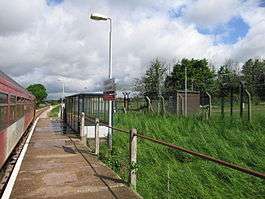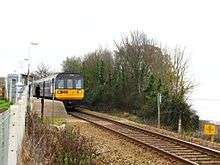Lympstone Commando railway station
Lympstone Commando railway station is a railway station on the branch line from Exeter to Exmouth in Devon, England.
| Lympstone Commando | |
|---|---|
 | |
| Location | |
| Place | Woodbury |
| Local authority | East Devon |
| Coordinates | 50.6623°N 3.441°W |
| Grid reference | SX982857 |
| Operations | |
| Station code | LYC |
| Managed by | Great Western Railway |
| Number of platforms | 1 |
| DfT category | F2 |
| Live arrivals/departures, station information and onward connections from National Rail Enquiries | |
| Annual rail passenger usage* | |
| 2014/15 | |
| 2015/16 | |
| 2016/17 | |
| 2017/18 | |
| 2018/19 | |
| History | |
| Original company | British Rail |
| 3 May 1976 | Opened |
| National Rail – UK railway stations | |
| |
The station was originally private for the exclusive use of visitors to the Royal Marine Commando Training Centre at Lympstone. Exit was originally through a locked gate into the commando base but a foot/cycle path was built between the station and the commando base enabling access to/from the station.
History
The station was opened on 3 May 1976 by British Rail. This caused some confusion with the older Lympstone railway station, but this has since been renamed "Lympstone Village".[1] It was built using cast platform sections recovered from Weston Milton railway station where the track had been singled and so one platform was no longer needed.
For many years troop trains were a feature of its operation about three times each year. The trains were operated with a locomotive at each end as there is no way to run around a train south of Topsham; the leading locomotive on arrival was dragged back to Exeter Central where it was detached. The trains were considerably longer than the platform and loading the passengers was a slow operation as they had to make their way through the train from the centre coaches. A similar operation today is difficult to arrange as the regular timetabled passenger service is much more intensive than in the 1980s.
Description
The station is situated on the banks of the estuary of the River Exe. It consists of a single platform, which is on the left of trains arriving from Exeter.
On 28 May 2010 a section of the Exe Estuary Trail opened between Lympstone village and Exton.[2] This runs between the platform and the entrance to the camp[3] so the public can now access the station, although the sign on the platform still remains stating “persons alighting here must have business with the camp”. The Ministry of Defence have accepted that the station is the property of Network Rail and as such they cannot prohibit members of the public from using the station, although the gate remains locked.[4]
Services

About half the trains on the Avocet Line from Exmouth to Exeter St David's and Paignton call at Lympstone Commando. It is a request stop, meaning that passengers alighting here must tell the conductor that they wish to do so, and those waiting to join must signal clearly to the driver as the train approaches.
Connections are available at Exeter Central for Barnstaple, Honiton and other stations including London Waterloo; passengers for other main line stations should change at Exeter St David's.[5]
| Preceding station | Following station | |||
|---|---|---|---|---|
| Exton | Great Western Railway Avocet Line |
Lympstone Village | ||
References
- Mitchell, Vic; Smith, Keith (1992). Branch Lines to Exmouth. Midhurst: Middleton Press. ISBN 1-873793-00-6.
- "East of the estuary". latest News from the Estuary. Exe Estuary Management Partnership. Archived from the original on 3 August 2012. Retrieved 17 January 2012.
- See Geograph photograph
- FOI request sent through Whatdotheyknow
- "National Rail Timetable 136" (PDF).
External links
| Wikimedia Commons has media related to Lympstone Commando railway station. |